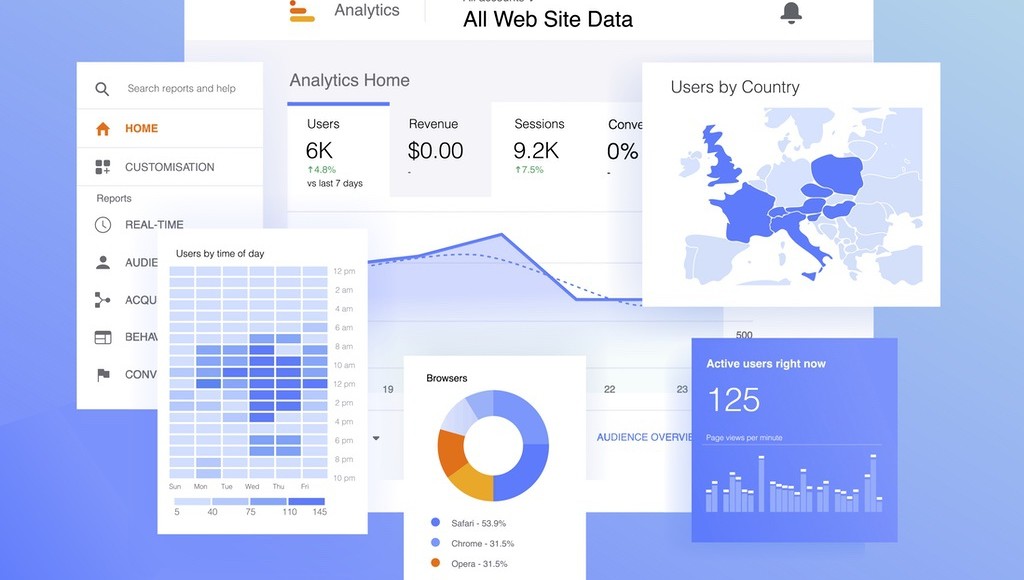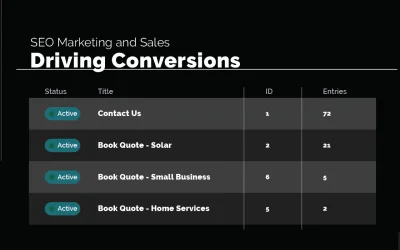Summary
- Useful KPIs for measuring the success of your digital marketing campaigns include site traffic, conversion rates, bounce rates, click-through rates (CTRs), customer lifetime value (CLV), and overall ROI.
- You can use tools like Google Analytics to track website traffic and bounce rates, Google Ads to monitor ad performance, and Hubspot to find your CLV.
- Best practices for reporting the results of your campaigns to stakeholders include providing visual representations of data, comparing results with competitors or industry benchmarks, and offering actionable recommendations for improving future campaigns based on collected data.
Learning how to track your online marketing efforts empowers you to make data-driven decisions that keep your campaigns efficient and your business growing. But with so many tools and so much data available, knowing where to start and what to focus on for maximum results can be a challenge.
Tracking analytics is how we provide measurable ROI for our paid digital marketing campaigns and SEO, so we’re here to help you get oriented. Learn about essential metrics to track and the tools you can use to do it below, plus find tips for reporting your results and using the data you collect to improve future efforts.

Via Adobe Stock.
Key Performance Indicators: An Overview
Key Performance Indicators (KPIs) are quantifiable metrics that help you measure the success of a given campaign. These critical data points enable you to track progress towards your goals, allowing you to identify what’s working, what’s not, and where to allocate resources for maximum impact. Choosing the right KPIs to monitor makes it easier to optimize your marketing strategy and drive growth for your business.
Critical KPIs to Monitor for Your Next Campaign
Not every single statistic you can pull from a piece of software will be broadly useful, so the first step in effectively measuring your campaign’s impact should be choosing the right KPIs to focus on. The KPIs that will give you the most actionable data right off the bat include:
- Website Traffic: The number of visitors to your site. This indicates the overall reach of your marketing efforts, helping you gauge awareness and interest in your brand.
- Conversion Rate: The percentage of visitors who complete a desired action. This helps you assess how effective your campaign is at driving users to take a specific action, like making a purchase or signing up for a newsletter.
- Click-Through Rate (CTR): The percentage of users who click on an ad, link, or call-to-action. It’s a valuable KPI for evaluating the performance of your ad creatives and placements, enabling you to optimize your campaigns for better engagement.
- Bounce Rate: The percentage of visitors who leave your site after viewing only one page. This helps you identify potential issues with your website’s user experience or content so you can make improvements that retain visitors and improve engagement.
- Return on Investment (ROI): The revenue your marketing efforts produce relative to their cost. Monitoring this helps you ensure that your investments are generating positive returns.
- Cost Per Acquisition (CPA): CPA calculates the average cost to acquire a new customer or lead. This KPI is essential for optimizing your marketing budget and identifying the most cost-effective channels and strategies for customer acquisition.
- Customer Lifetime Value (CLV): The total revenue your business can expect from a single customer over the course of your relationship with them. Tracking CLV lets you focus on nurturing long-term customer relationships and developing marketing strategies that maximize the value of each customer.

Via Adobe Stock.
Recommended Tools for Tracking Your Campaigns
Once you know what to look for, it’s time to consider how—specifically, the tools you’ll use to find this data. Here are some of our recommendations:
Google Analytics
This powerful web analytics tool can help you track website traffic, user behavior, and conversion goals to optimize your digital marketing efforts and improve user experience.
Use it to measure:
- Website traffic
- Conversion rates
- Bounce rates
Google Ads
An online advertising platform that enables you to create, manage, and measure the performance of your pay-per-click (PPC) campaigns so you can optimize ad spend and maximize ROI.
Use it to measure:
- Click-through rates
- Cost per acquisition for PPC campaigns
- ROI (based on ad spend and revenue generated)
Facebook Ads Manager
A comprehensive advertising management tool for creating, analyzing, and optimizing Facebook and Instagram ad campaigns, allowing you to effectively target your audience and drive better results.
Use it to measure:
- Click-through rates
- Cost per acquisition for social media campaigns
Hubspot
An all-in-one inbound marketing, sales, and customer relationship management (CRM) platform that provides essential data for managing digital marketing campaigns, nurturing leads, and boosting customer retention.
Use it to measure:
- ROI (based on ad spend and revenue generated)
- Customer lifetime value (based on purchase frequency, average order value, and customer lifespan)

Via Adobe Stock.
Reporting Your Results
Depending on the tools you choose for collecting your metrics, you’ll have several options for compiling and presenting your data to stakeholders. But no matter what platform you use to report your campaign’s results, here are a few best practices to follow:
Represent Data Visually
Visualizing data using charts, graphs, or infographics makes it easier for stakeholders to grasp complex information, allowing them to quickly understand trends and patterns in the campaign’s performance. Effective visuals can also improve engagement and facilitate better decision-making.
Provide Comparisons
Placing your campaign results in the context of competitors or industry standards enables stakeholders to assess your business’s relative performance, helping them identify areas where your marketing efforts excel or need improvement. This comparative approach fosters a better understanding of your market position and supports strategic planning.
Offer Clear Next Steps
Analyzing the data from your campaigns and providing specific, data-driven suggestions for improvement demonstrates your commitment to continuous optimization and growth. This approach ensures that your marketing strategies evolve in response to performance insights, leading to more effective campaigns and better results for your business.
Your Marketing Data Is a Road Map
The information you collect from your marketing campaigns tells you where you should go next, what obstacles lie between you and your goals, and the best way to reach your destination effectively. Learning how to read the map correctly is a skill that takes some time and practice, but the results are real and measurable.
Use what you’ve learned above to become more familiar with the right insights from your digital marketing campaigns, and reach out to the Monochrome team if you feel like you could benefit from expert guidance. Our data-driven approach has helped us lead clients in a wide variety of industries towards their goals, and we’re happy to do the same for you.






